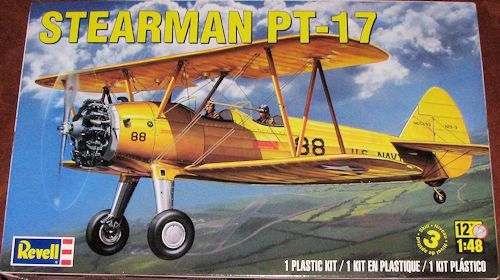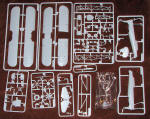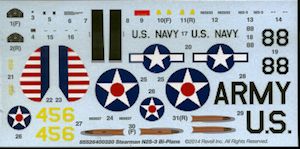
Revell 1/48 Stearman PT-17
| KIT #: | 5264 |
| PRICE: | $16.95 SRP |
| DECALS: | Two options |
| REVIEWER: | Scott Van Aken |
| NOTES: | New tool kit |

| HISTORY |
The Stearman (Boeing) Model 75 is a biplane used as a military trainer aircraft, of which at least 8,584 were built in the United States during the 1930s and 1940s. Stearman Aircraft became a subsidiary of Boeing in 1934. Widely known as the Stearman, Boeing Stearman or Kaydet, it served as a primary trainer for the USAAF, the USN (as the NS & N2S), and with the RCAF as the Kaydet throughout World War II. After the conflict was over, thousands of surplus aircraft were sold on the civilian market. In the immediate postwar years they became popular as crop dusters, sports planes, and for aerobatic and wing walking use in airshows.
The subject of this kit is the PT-17, a variant that was powered by a Continental R-670-5 engine. 3,519 delivered. Its navy equivalent was the N2S-3, powered by the -4 version of the R-670. 1,875 were delivered. There are literally dozens of these rugged and easy to repair aircraft still flying world-wide.
| THE KIT |
 Prior
to this kit being released, we had, in1/48, the Lindberg kit as the only
injection molded Stearman. It built into a very nice model, but was very much a
kit of its times and was quite light on interior detail. In fact, you got a
plastic plank on which to sit the two crew figures. When I decided to build one
for the San Diego Aerospace Museum back in the early 1980s, I was able to get
scans of the interior of this aircraft and scratch built a full interior for the
Lindberg kit, complete with framework. It was a lengthy project of which I was
quite pleased when done. Hopefully it is still on display in the model room. Now
I don't need to do all that work!
Prior
to this kit being released, we had, in1/48, the Lindberg kit as the only
injection molded Stearman. It built into a very nice model, but was very much a
kit of its times and was quite light on interior detail. In fact, you got a
plastic plank on which to sit the two crew figures. When I decided to build one
for the San Diego Aerospace Museum back in the early 1980s, I was able to get
scans of the interior of this aircraft and scratch built a full interior for the
Lindberg kit, complete with framework. It was a lengthy project of which I was
quite pleased when done. Hopefully it is still on display in the model room. Now
I don't need to do all that work!
Revell have decided to produce a new tool Stearman for the 1/48 modeler. They have done their homework on this one and while I'm not an expert on any aircraft, it seems to me that they have missed nothing. First off the kit comes with a complete interior tube framework on the bottom and sides. Into this fit the seats, sticks, throttles and other bits and pieces. This assembly is then trapped between the two fuselage halves. Inside the fuselage halves are all the ribs and stringers (as well as some small ejector pin marks).
As you might expect, the upper forward fuselage section is separate and into this fit the two instrument panels. There are decals to put over these as the plastic is simply raised circles for instruments. For the bottom of the forward fuselage is a small section the includes the inside of the landing gear legs. A tube engine mount fits onto the forward firewall. To this is attached the R-670 engine that has rear exhaust along with an accessory section.
There are separate side panels to the accessory section and while they are designed to be glued in place, an adventurous modeler could easily figure a way to make them removeable. Two different props are provided; one metal and the other wooden. For the wooden prop, Revell has provided wood grain decals for the front and back, a nice addition. There is no indication of which of the markings options uses which prop until you get to the markings page. There you notice that the Navy version has the metal prop.
The upper wing s in two halves and includes the two upper hand holds often missed on this aircraft. For the bottom wing there is a lower section with two upper sections. Hand holds are molded into the wing tips. It is with the installation of the lower wing that the first of the rigging diagrams starts. While the diameter of the wire is not given, the length of each one is provided. This is repeated in the final step with the rest of the flying wires. In this page are also photos of a built up model to show the wires in place. I was sort of hoping that there would be small dimples on the inside of parts to show where to drill holes for wire application, but that is not the case.
 Instructions
are well done and are very easy to follow, providing Revell USA's normal generic
paint color information. Markings, which include the wing walk areas, are for
two planes. One is a USAAC/F PT-17 with a blue fuselage and yellow flying
surfaces, complete with the red and white rudder stripes as would be typical for
early war planes. The other is an all yellow Navy N2S-3 as shown on the box art.
I am sure that some research will turn up some alternate schemes for this
aircraft and I'll bet aftermarket decals are not far off. The kit decals are
nicely printed and should work well.
Instructions
are well done and are very easy to follow, providing Revell USA's normal generic
paint color information. Markings, which include the wing walk areas, are for
two planes. One is a USAAC/F PT-17 with a blue fuselage and yellow flying
surfaces, complete with the red and white rudder stripes as would be typical for
early war planes. The other is an all yellow Navy N2S-3 as shown on the box art.
I am sure that some research will turn up some alternate schemes for this
aircraft and I'll bet aftermarket decals are not far off. The kit decals are
nicely printed and should work well.
| CONCLUSIONS |
I am sure that a lot of folks will be quite pleased with this one. For one thing, it doesn't cost forty dollars or more and seems to have all the detail that most will want. Now one has to be careful when going to alternate schemes as the PT-17/N2S was produced with a variety of engines, some of which had the exhaust collector in the front of the engine. I'm not sure if Revell will issue another boxing, but time has shown that Revell USA usually does not do multiple boxings of a kit. Regardless, they have picked the most widely produced variant and I know that those who do not mind a bit of rigging will be very happy with this one.
| REFERENCES |
http://en.wikipedia.org/wiki/Stearman_PT-17
February 2014
Thanks to me for picking up the preview kit.
If you would like your product reviewed fairly and fairly quickly, please contact the editor or see other details in the Note to Contributors.